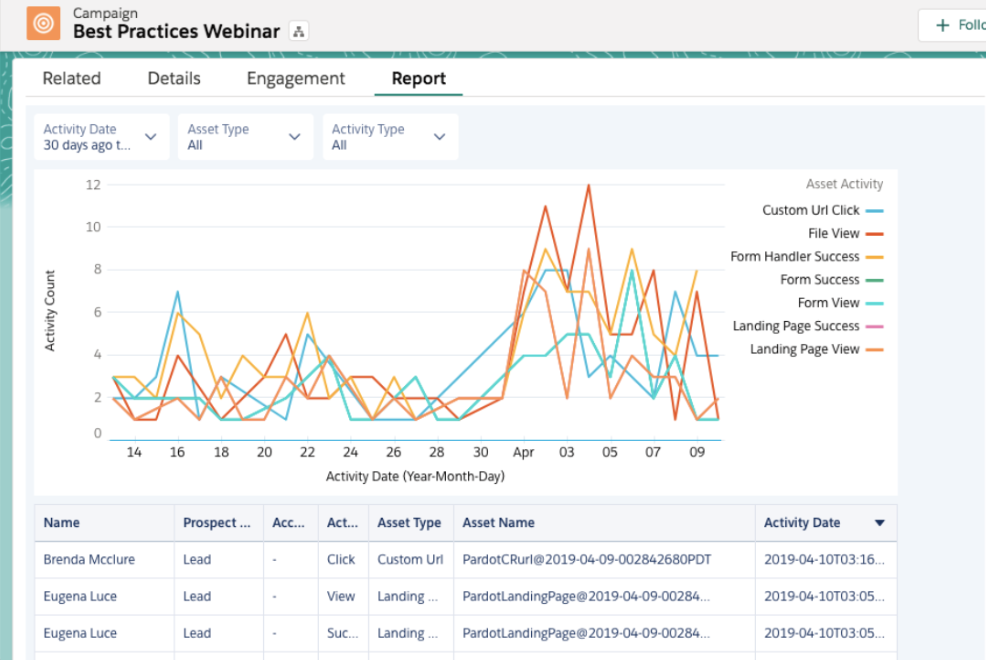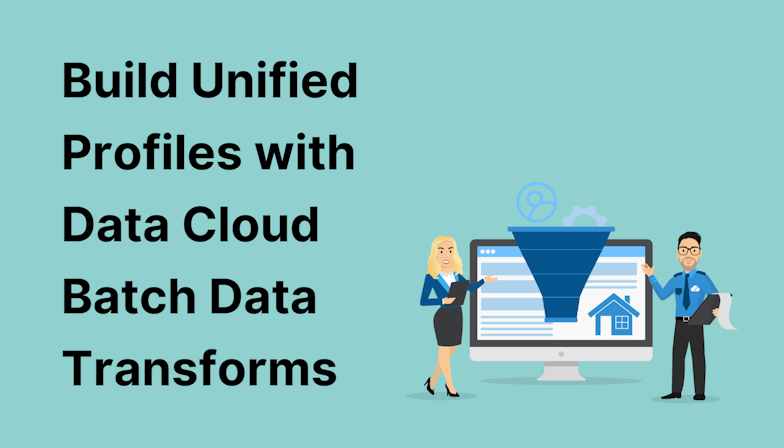This blog was written before Pardot was renamed to Marketing Cloud Account Engagement. You can read more about the name change and what it means here.
Achieving accurate Pardot campaign reporting is a challenge many marketers face. So I started this blog post intending to clear up some questions about campaign attribution that I get asked frequently.
Before I knew it, I had written this mammoth guide on Pardot campaign reporting, with all of the ins and outs of B2B marketing analytics, campaign reporting, and multi-touch attribution included. You’re welcome!
Correctly attributing sales to multiple touch points and campaigns isn’t a nice-to-have but a must-have!
So, if you’re reading this and find anything unfamiliar with the tools and approaches I’m talking about then please do drop me a message and I can clear up any areas of confusion.
Let’s start with the ideal Pardot campaign attribution scenario…
The Pardot Campaign Reporting Dream
Example:
- Daisy sees your great post on LinkedIn and clicks to visit your website, which triggers the tracking code. Lead Source = LinkedIn.
- Daisy downloads a product-specific technical guide via a Pardot form because your content is awesome and she’s interested in the details, nice work. She opts-in too, but let’s not talk about GDPR here, time and place…
- Daisy is then associated with the Pardot Campaign associated with her first touchpoint. Let’s call this Campaign Website Tracking’.
- Daisy becomes part of a nurturing program and is associated with the Salesforce Campaign Nurture2020- Status Joined’.
- Daisy signs up for a webinar and attends, is associated with the Salesforce Campaign Webinar - Status Attended’.
- Daisy achieves the correct score & grade so is automatically assigned to a sales user (MQL).
- A £20,000 Opportunity is then associated with Daisy (SQL) and she is added as a contact role to this opportunity (important for Pardot to see who is attached to what).
- The Opportunity closes. In Pardot, we see £20,000 ROI associated with the first touchpoint; Website Tracking.
- We head to B2B Marketing Analytics and look at our multi-touch campaign attribution report because we have a custom model set up and see that we’re associating £10,000 to the Website Tracking campaign, £3,000 to the Nurture2020 Campaign and £7,000 to the Webinar Campaign!
- We all celebrate as a single team and marketing gets all the credit they deserve and sales thank them for said efforts!
Step 10 was completely made up.
Daisy is also fictional, although she seems more realistic than step 10…
So how do we even begin to set our Pardot account up in a way that will accurately attribute sales to our individual Campaigns?
Well, there are a handful of Pardot features that need to be considered. These are:
- Connected Campaigns
- Lead Source & UTM Tracking
- Campaign Hierarchy
- Engagement History
- Pardot Content Strategy
- B2B Marketing Analytics
When Do I Need To Set Up A Campaign?
It depends on what you’re tracking.
A Campaign is essentially a mechanism for us to group assets & objects together so we can fully understand where ROI is coming from.
An easy one I go by is if you’re spending money on something, you may need a campaign for it. For example, LinkedIn ads, a new website as part of a rebrand, Organic posts (bonus ROI - or you can use staff costs!), events, webinars, the list goes on.
Your time is paid for, so make sure you’re tracking these organic’ activities because there’s always a cost somewhere.
Connected Campaigns
Great multi-touch attribution starts with Connected Campaigns.
Note how in the above example, Pardot used the first action as the source campaign but B2B Marketing Analytics used this as a point of reference (the first touchpoint).
Connected Campaigns really help with custom campaign attribution models.
These campaigns have a 1-1 relationship with a prospect in Pardot and show where the ROI should be directed in terms of a Source Campaign’.
The Pardot campaign will house all of the assets associated with a marketing campaign (Landing pages, emails, forms, links…). It all becomes clearer when we look at Engagement History a little later in this post.
Now, I won’t go into detail on how to turn Connected Campaigns on because Salesforce have already done this here. But, I will say that if you haven’t got Connected Campaigns turned on yet then please do!
Pardot always tries to work backwards and work out where prospects came from. To see the full list of sources it can actually work out, see here: How a Prospect’s Source Field Is Populated.
However, the above will be superceded if you are using Google UTM parameters in your URL.
I must stress something here because it catches everyone, the UTM information will only populate when it’s the prospect’s first touchpoint only. This is absolutely key. If the prospect triggers the Pardot tracking code in any capacity beforehand, the UTM info won’t populate.
![]()
Campaign Hierarchy
Chances are, you may not have a clear strategy in place yet for Pardot Campaigns.
Don’t feel bad about it though, I’ve noticed that the main reason businesses don’t have this clear vision yet is mostly because there’s no real understanding or visualisation of why we need this robust structure in place.
Subsequently, teams just tend to hone in on the granular metrics and this is essentially how and why vanity metrics were such a big thing for such a long time.
An example of how you can manage Campaign hierarchy is available on Trailhead.

Source: Organize Campaigns with Hierarchies and Record Types
But why is Campaign hierarchy important?
Engagement History
Engagement history allows you to see your more granular metrics rolled up into an easy to understand dashboard. The metrics can include child campaigns which is why the Campaign hierarchy is so important!

Source: Using Engagement History Lightning Components

Source: How to Report on Marketing Activities with Engagement History
The below image illustrates why we need to associate marketing assets correctly in Pardot to the relevant campaign:

Source: How to Report on Marketing Activities with Engagement History
Pardot Content Strategy
It’s all well and good having Pardot Campaigns set up but content is what drives marketing automation, so we need to know what we’re doing on the content strategy front too.
Take a look at the below image. This is an amazing graphic that focuses on buyer intent and uses common sense to infer how engaged a prospect might be.

Source: How to Send the Right Content at Every Stage of the Sales Cycle
Let’s think back to what Daisy was doing on the website. Clearly she was interested in the business and based on her downloading the product-specific technical guide we can assume that she must be somewhat ready to buy! Who else would want to read those types of details?
Therefore, we’ll put that particular guide in stage 3. Stage 3 infers strong buying signals so let’s score higher for that content. Generic blogs are very top level and do well for brand awareness but not for closing a sale so clearly, that’s stage 1.
Now we’re strategising…
B2B Marketing Analytics For Tracking ROI
B2B Marketing Analytics pulls data from both Pardot and Salesforce, making it an extremely powerful tool in your reporting arsenal.
You’ll be able to create granular reports using near real-time data which is exceptional for organisations who want to make data-driven decisions.
Think about any time a prospect can engage with your brand, this could be seen as an opportunity for a prospect to become part of the Salesforce campaign.
What we’re doing here is creating a small mark on the prospect record to say they engaged at some point with that marketing effort. Later on if they ever convert, we can work out how important that engagement actually was in terms of getting the conversion.
Combine this type of reporting with a custom multi-touch attribution model and you’ll be able to clearly see where revenue is being generated.
Now we see why Connected Campaigns combined with a sensible campaign hierarchy and naming conventions are so important.

Source: Introducing Multi-Touch Attribution in B2B Marketing Analytics
Where to start with multi-touch Campaign reporting
Well, that depends on your knowledge and understanding of Pardot right now. If you’re an intermediate or advanced user, you may feel comfortable jumping into each of the areas covered in this post and doing the set up yourself.
If that’s not the case and you’re a beginner, time-poor, or simply prefer to outsource the heavy lifting of your Pardot account, MarCloud is here to help with the how’.
Drop me a message via our contact form and we’ll work together on a tangible plan that we can implement to get you to this level of Pardot Campaign reporting.

Tom Ryan
Founder & CEO of MarCloud, Tom has been on both sides of the fence, client-side and agency, working with Salesforce platforms for the best part of a decade. He's a Salesforce Marketing Champion and certified consultant who loves to co-host webinars and pen original guides and articles. A regular contributor to online business and marketing publications, he's passionate about marketing automation and, along with the team, is rapidly making MarCloud the go-to place for Marketing Cloud and Salesforce expertise. He unapologetically uses the terms Pardot, Account Engagement and MCAE interchangeably.
More by Tom RyanFeatured resource

How to Measure ROI Using Pardot
Proving ROI is the holy grail for marketers. In our ‘How to Measure ROI Using Pardot’ eBook, you’ll find a detailed list of all the steps you need to take to fully track and report on marketing attribution and return on investment. If you can make it through the guide with every single checkbox ticked, you can consider yourself a true expert!
Download now



